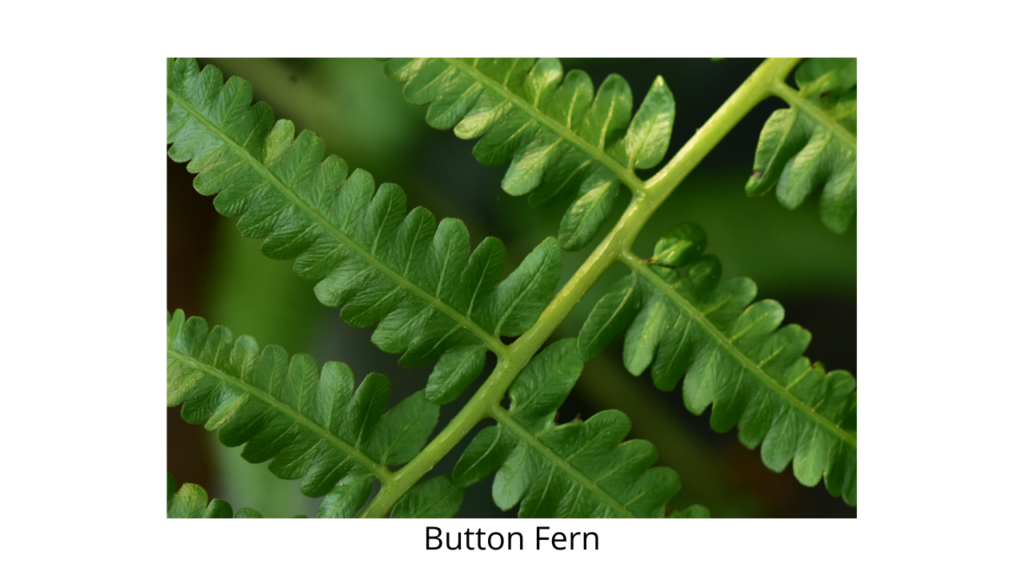Button fern is a variety with very beautiful foliage that flourishes well as indoor plant with little care. Its round arching fronds make it prominent and add elegance to any brightly lit place. Button fern has got signature foliage unlike its fellow family members. Its botanical name is Pellaea Rotundifolia wherin Rotund means round and pellaea indicates dark. Young button fern’s fronds appear green which turn into darker shade as the plant grows and becomes older. These ferns have very high tolerance for low moisture, temperature and humidity. However button ferns can’t stand soggy soil.

Table of Contents
Button Fern – Specifications
Common Name : Button Fern, The round –leafed fern
Botanical Name : Pellaea Rotundifolia
Plant Type : Evergreen, round leafed vascular plant
Plant size : 1 1/2 feet tall. Fit for Indoor/house Plant
Sunlight Requirement : Dappled and bright Sunlight only. No direct light.
Temperature : 65-75 deg.F
Soil : Well drained, Acidic, should not be acidic.
Flowering Pattern : Flowerless and seedless
Nativity : NewZealand.
Best Season to plant : Spring and Early fall.
Hardiness Zone : USDA – (8-9)
Are Button fern hard to care for?
Even a novice beginner gardener can grow Button fern and make it flourish with little care during its initial stages of life. As compared to its fellow varieties, it’s an easy-to-grow type
As a result they prefer high humidity and moisture. However never allow them to go dry.
- Button ferns have high tolerance to poor /under watering. It tolerates fairly dry conditions. But can never tolerate over watering or soggy soil which would lead to wilting of leaves. If the leaves turn yellow and start wilting, kindly check if it has already led to root rotting. If the roots are already black, it means that button fern plant has already suffered root rot and nothing can be done. It’s better to do away with the plant.
- Apply fertilizer once a week. It should be a 20-20-10 balanced liquid fertilizer. During severe winter, there is no need for fertilization.
- Ensure that the water is at normal temperature. Let it not be extreme.
- Contrary to the behavior pattern and high tolerance levels to drought, Lemon button fern can’t stand drought. Even a small period of dryness will make the plant to shed its leaves .The leaves also turn crispy.
- Ensure that button indoor plants are kept in brightly lit place inside the home. Do not expose them much to direct sunlight for longer period of time.
- Button ferns thrive well in environment having 50% relative humidity. If it’s not possible inside home condition, do use a humidifier to elevate the humidity levels.
- They flourish well at a temperature range of 60 to 75 deg. F to avoid. Maintain the optimum temperature to avoid any drafts.
- For outdoor ferns, water it twice a day during summer.
- Do not bother much about growth as Boston fern have slow growth, more so during winter.
- Boston ferns are planted in pots with high level of peat moss. It is necessary to hydrate the peat mass of the pot .
- Repotting: The plant needs to be repotted every year as it will outgrow its container by that time. It’s better to repot in a bigger one with proper drainage facility.
- Button fern can be easily propagated by dividing the root system and planting them individually in various pots.
Can we divide and propagate?
One can easily propagate a button fern . The propagation has to be done during the spring season, when it starts active growth. It is done by splitting at the roots and growing the parts in separate pots . We can cut through the root balls into as many segments. Once potted, each segment would grow into a separate button fern plant.
How do you water ?
Button fern has unique leathery and shiny round dark leaves . Unlike its fellow varieties, this fern can withstand dry conditions
- Hence water them with higher intervals, either weekly or more often depending upon the humidity levels and temperature.
- As already told, button ferns flourish well on higher humidity levels, at least 50 % and above. Exposure to dry conditions and poor humidity will make the plant wilt its leaves.
- Since maintaining higher levels of humidity may not be possible at home conditions one alternative is to mist the leaves few times a day. The leaves appearing saggy and droopy are one indication that the plant is in a low humid environment.
- Ensure that moisture is maintained in the pot soil continuously. At the same time, never allow water-logging in the soil making it soggy. This will surely lead to root rotting and plant death
- Check the top soil between each watering so that you don’t end up over watering. Excess watering is more dangerous than under watering.
Button fern as Outdoor and Greenhouse plant :
Outdoor Button Fern
Button ferns need to be preferably planted in spring. In outdoor conditions, button fern should be planted on a place with a mixture of shade and dappled light. Any location with partial sunshine would be ideal for it. Do not expose them to complete sun. But under any circumstances, avoid water-logged soil.
Greenhouse Button Fern
Button ferns can thrive well in Greenhouse under the following conditions:
- The greenhouse enclosure should allow not more than 50% light in to it . Ares with shade can be created across the greenhouse or at specific locations where button fern is planned. This will help them not to get exposed to 100 % light.
- As in the case of outdoor environment, do not allow the soil to be soggy,
Button ferns are very interesting and unique type as compared to their fellow family members, with respect to appearance and characteristics. Waiting for your views and comments Cheers !
